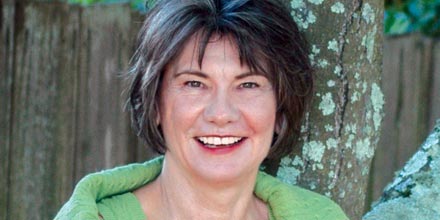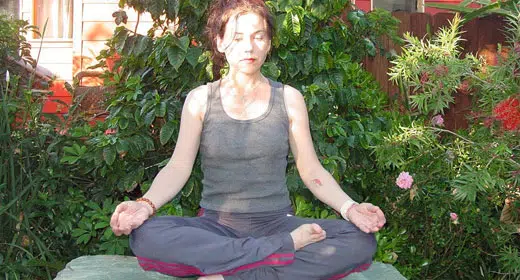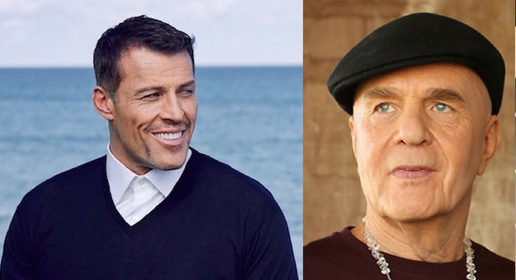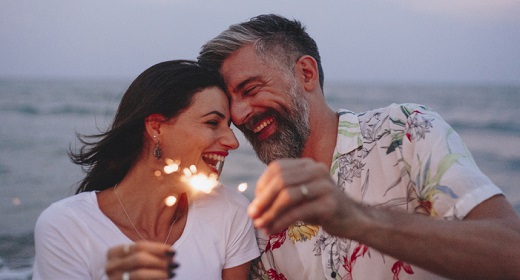by Kathryn Drury Wagner: A conversation with sex therapist Maci Daye on the importance of bringing play, adventure, and curiosity into the bedroom…
and why “Great sex has more to do with the state of our mind than with the function of our body.”
Sex and intimacy can be hard subjects to broach, even within longtime relationships. Yet many of us crave an erotic reconnection with our partners. As a licensed professional counselor and certified sex therapist with more than 25 years of experience, Maci Daye has based her new book Passion & Presence: An Awakened Couple’s Guide to Mindful Sex on the retreats she conducts with couples all over the U.S. and internationally. Daye uses methods to get couples back on what she calls the “naked path.” It’s like enlightenment, only … naked, a path that helps remove judgment, fear, and disconnect that can naturally arise during the aging process and after decades of coupledom. In this conversation with S&H, Daye shares some of her insights.
S&H: Where did this idea come from, that sex should remain spicy in a long-term relationship? And do you think that is a recent development culturally?
Maci Daye: The idea that sex should be an enduring feature of a long-term relationship is a recent socio-cultural development. Today, we have many relational choices, including the option not to partner at all. When passion fades, we can trade our partner for a newer model, which is why Esther Perel says that sexual satisfaction is a mandate in current relationships.
Medical advances, such as hormone replacement therapy and erectile enhancers, have also contributed to the view that age does not have to be a “show-stopper.” Another factor is that the baby boomers put a premium on health and vitality. Research shows that sexual health is an essential component of overall well-being. Regular sex may prevent heart disease, even cancer, and thus can promote longevity as well.
However, I want to comment on the word “spicy,” which conjures up images of “hot” or “frisky.” In my view, the only kind of sex we should be having is the kind that feels good and makes us happy with each other. The words we use shape our models of “right” and “wrong” sex. If we privilege “spicy” over different flavors, we may opt-out of sex if we don’t crave “hot food.” We may also lose touch with our inherent eroticism.
In contrast, a mindful approach to sex is open and exploratory; it fits the moment and our changing capacities. We can enjoy rewarding sex across the lifespan when we acknowledge and continually adjust to fluctuations in our energy, cravings, and mood.
You write quite a bit about shame and how that rears its head in the dynamic between couples. This feels like a big component that people may not realize is present. Can you talk about that?
Thanks to Brene Brown’s research, we now understand that shame is the feeling that something is wrong with us and we don’t belong. In relationships, this can lead to hiding and retreating and sexual avoidance because sex is so naked. It exposes everything we try to cover through clothes, impressive jobs, and other acceptability markers.
Unfortunately, shame is hard to detect because it disguises itself as depression, anger, addiction, and other social ills. We have to look for shame indicators, such as wanting to disappear, going out of contact, even a trauma-like freeze response to uncover the shame and finally heal it.
The antidote to shame is a connection—with others and also ourselves. Whenever we start to judge ourselves and our partners for looking, feeling, thinking, or behaving a certain way, we can suspect shame is nearby. Instead of steering clear from our shame, which is disconnecting, we can offer loving-kindness to whatever we judge about ourselves or our partners.
We can go even further and eroticize what we find shameful by giving hidden parts of ourselves a starring role in our sexual theater. The good news is that by making our shared erotic space a shame-free zone, partners can be each other’s healers when shame pops up, as it inevitably will. Healing shame through awakened intimacy is how the erotic portal can be a transformational path.
There’s a stereotype that women only want one partner, and men seek adventure and want more. Yet overfamiliarity can kill women’s sex drives, too, right?
It’s a little-known secret that women often get bored in monogamous relationships sooner than men. Perhaps because of their cycles, vulva-bodied people tend to be mutable. Their desires are fluid, like water, rather than fixed. Therefore, once they fall into a regular sexual pattern, they may lose interest in partner sex.
I find it problematic to generalize about the sexes, especially as we reconsider the gender binary; however, most women I’ve worked with have a vast erotic imagination. They crave variety, nuance, whole-body sensuality, seduction, and novelty. In heterosexual relationships, the foreplay script followed by intercourse is too limiting and goal-directed, for many, which translates as dull.
Moreover, vulva-bodied people have enormous pleasure potential, as evidenced by having a clitoris with 8,000 nerve endings intended for nothing but pleasure. However, direct genital contact may be uncomfortable, even threatening before full engorgement of the surrounding tissue. Setting a context for sex that allows them to shift into an eros-enhancing state first can help them access and express their erotic creativity.
Unfortunately, even progressive women may assume a passive and receptive role unknowingly. Sexual scripts are still mostly gendered. Heterosexual women may be more used to seeing themselves as the object of their partner’s fantasies, not the star of their own. Trusting their desires, openly expressing them, and shaping partnered sexual encounters may require doing some personal work first, but the rewards are plenty—for both partners.
I developed a model called “whole-person multimodal sex” to help partners of all genders explore new erotic pathways and partake in the vast banquet eros lays out for them.
You’ve conducted the Passion and Presence workshops internationally as well as around the United States. Do you find any difference in cultural values with sex or are the issues fairly consistent among the couples who attend your workshops?
Couples everywhere falsely believe that only they have problems and that most people have great sex. In that regard, I sometimes see myself as a bearer of relief – and hope – for couples experiencing the inevitable challenges of “real-life” sex.
The couples that have attended our retreats in Europe, Australia, New Zealand, Mexico, and the USA experience shame, low or discrepant desire, unhealed erotic wounding, performance pressure, bedroom boredom, and sexual avoidance at comparable rates. These issues also appear across ages, orientations, and genders.
Regarding cultural values, I’ve found more acceptance of polyamory in the Pacific Northwest than other regions of the United States, and possibly a greater comfort in talking about sex.
You write that “Great sex has more to do with the state of our mind than with the function of our body.” This is so liberating! This is especially important as we age, right? But I also love it in terms of disability rights, accessibility issues, recovery from illness …
Being embodied and attuned and cultivating a present, curious, and exploratory attitude is what makes sex great at any age, regardless of genital function, health, or ability. Research bears this out. Peggy Kleinplatz directs the Sex and Couples Therapy Training Program at the University of Ottawa and studies “Optimal Sexuality.” Her subjects include people over sixty-five years old in relationships of at least 25 years who insist they have “great sex.”
I think it’s worth taking a mindful pause to let this in.
Here’s where my interest peaks: None of the respondents attribute their sexual satisfaction to performance quality or technique. Her findings indicate that what makes sex great is being present in an embodied way, what I would call being mindful.
As a sex therapist, I’ve found that what prevents us from having great sex is rarely a lack of physical flexibility, strength, vigor, or climax ability. Instead, most of us have internal barriers to satisfaction, such as limiting beliefs and expectations. Yet most sexual enrichment programs focus on performance solutions.
I also encourage my clients to expand their definition of sex to include myriad forms of erotic expression that may or may not involve genital contact, intercourse, or orgasm. When we widen the frame of what constitutes “real“ sex, every-body can be sexual at any stage of life.
How do couples react when you ask them to imagine that sex is a way to merge with “the great all” (the divine, the mystery)?
I want to stress that I don’t claim that spiritual sex is the apex of eroticism. A mindful approach is without goals and expectations. It is an unscripted call and response with eros in its many guises.
I use this scenario as a thought experiment to show how our intentions and expectations shape our experiences before we begin to relate physically. For example, when we imagine opening in this way, we might notice that we feel the energy pulsing off the surface of our skin. The scenario might conjure a particular emotion or suggest specific movements, and a way of connecting that is both primal and transpersonal.
Some people might enter an ecstatic state, even though they are sitting at their desks. I like to stress that whatever happens with this experiment occurs in their head, not in their bed. Our expectations shape us for better or worse. For example, many of us expect to be disappointed or exploited. We start to shut down and get angry at the mere suggestion of sex. For this reason, I often ask couples, “Where’s your head on sex?“ I want to see how their expectations are shutting down their aliveness or generating eros-inhibiting states.
I also let people know that we have many motivations for having sex. Like the USDA food pyramid, I use a pyramid to show four sexual “food groups:“ Physical, emotional, psychological, and spiritual. The pyramid is a representation of the many ways we can nourish ourselves erotically.
Some people are relieved that sex can be a portal to spirituality and hunger for such an experience. The exercise enlivens and inspires them. Others can’t fathom what such sex might look like or have no desire for it.
In your book, the ideas of play, joy, and zest really come through. How is the element of play important in mindfully exploring sexuality?
According to the oxford dictionary, play is to “engage in activity for enjoyment and recreation rather than a serious or practical purpose.“ I say the same holds for sex. Many sexual problems result from a performance mindset, where the focus is on achievement, competence, and getting it right rather than pleasure and sheer enjoyment.
Mindfulness can help us attune to what the moment is asking of us rather than adhering to fixed plans. We let go of goals and surrender to the ever-changing now.
This freedom to wander—and wonder—can generate a state of awe, which is something many of us lose as adults. Mindfulness can help us develop an “anything is possible“ state of mind, which keeps sex fresh no matter our age or years together. Toward this end, I like to invite the couples to go off-script, which, like coloring outside the lines, is creative, engaging, and potentially fun. If we don’t like what we’ve made (or where we’re heading), we can always start over.
However, I want to clarify that we don’t need zest, and sex is not always joyful. It is sometimes painful and disappointing. Still, we can meet such moments with a spirit of acceptance and let go until the next time. We don’t have to strain to get it “right“ or judge ourselves if we don’t score a perfect “10“ every time. Mindfulness breeds acceptance of sexual variability so that we can look forward to pressure-free times in the future.









































